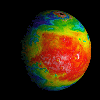|
JPL
Planetary Photo Journal |
|
01-MAY-2000 -- New animations of TES broadband visible and near-infrared reflectance! |
|
June
22, 2000 |
These two movies are animations of TES-derived global broadband (0.3 - ~3.0 microns) visible and near-infrared reflectance, also known as albedo. The scalebar shows the range of values in dimensionless units. The values are the ratio of the amount of electromagnetic energy reflected by the surface to the amount of energy incident upon it from the sun (larger values are brighter surfaces). The small version of the movie is ~600k and the large version is ~2MB. Small version (600k) Large version (~2MB) Mars Global Surveyor
|
|














